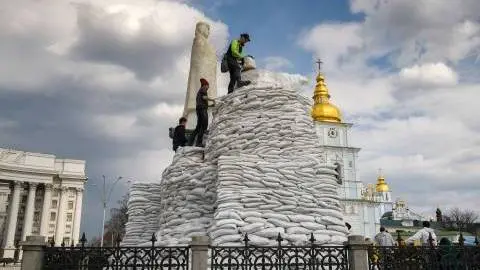The war in Ukraine is putting global supply chains to the test – again
Even before the war began, supply chain frictions had only improved marginally from the Covid-19 pandemic. Now, expect even longer-lasting disruptions, a new round of delays, and protracted supply shortages
The pandemic is not even over as the latest lockdowns in China illustrate, and the war in Ukraine is putting global supply chains through another test. Distortions in supply because of the destruction of war and disabled supply chains, sanctions, and voluntary self-sanctioning all hit trade. Consequently, extra customs inspections will delay handling and shipments, and detours have to be made, limiting transport capacities. The shortage of workers might also intensify. Around 14.5% of all seafarers come from Russia and Ukraine, according to the International Chamber of Shipping, and the closure of airspace has made travelling and relocation for seafarers more difficult. Many truck drivers are Ukrainian, possibly intensifying the estimated shortage of 400,000 truck drivers across the EU.
No economic sector can escape the surge in energy prices
Although Russia and Ukraine’s global trade share in exports and imports does not exceed 2%, both countries are crucial commodity exporters. In addition to energy exports, Russia and Ukraine export agricultural products such as wheat, corn, and sunflower oil and large amounts of commodities such as steel palladium, platinum, and nickel, amongst others. The EU, for example, imports 30.1% of its Extra EU nickel imports, 81% of its Extra EU nickel ores and concentrates, 48.5% of semi-finished products of iron or steel, and more than 20% of copper and platinum from Russia. Even if the trading amounts are not always high, there are clear dependencies in some areas. Low-income countries, in particular, rely on Russia's and Ukraine’s food and fertiliser exports.
What weighs even more heavily on consumers and producers is the surge in energy costs, however. Consumers have slashed their buying expectations, while for some producers it is already too costly to produce at all given high gas prices, adding to existing material bottlenecks caused by the pandemic. What is more, soaring fuel prices significantly push up transport costs. Continued uncertainty will keep commodity prices elevated throughout the year, affecting all links in the supply chain.
What this means for supply chains and our trade outlook
Delays and congestion suggest longer-lasting problems for supply chains. Sailing and air freight schemes have to be reorganised and delays will intensify as Russian products are subject to sanctions. Shippers will have to avoid the Euro-Asian railway through Russia. Delivery of crucial preliminary products to European manufacturers will be delayed – if delivered at all. On top of that, scarcity and new frictions in transport mean further price pressures, resulting in ongoing higher prices for producers and consumers on top of elevated energy prices. Contrary to supply chain frictions in the wake of the pandemic, the supply chain distortions due to the war in Ukraine will possibly be permanent. All supply chain frictions of the last two years, be it container prices, logistical issues, or production drops in microchips, will at some point in time be resolved. Supply chains hit by the war are unlikely to return to normal. Logistical routes might have to be rerouted for good. Imports from Russia might have to be replaced for good. The longer-term implications of these changes are still hard to quantify.
World trade will weaken more sharply than expected this year
We can say with high certainty that world trade this year will weaken more sharply than expected. Continued supply chain troubles following the pandemic and higher inflation and shipment costs pose further downside risks to our trade outlook. Sanctions on several products previously exported to Russia, voluntary bans on exports, and efforts to reduce oil and gas imports will all hit global trade this year. Nevertheless, we continue to expect some growth in world trade volume in 2022. The US economy and the Asian region, excluding China, have limited direct economic linkages to the area, which bodes well for continued trade, although they are not immune to the indirect consequences of this conflict, such as a sharp drop in demand from Europe.
Also, don’t forget that local lockdowns in order to combat Covid-19 pose another downside risk, as recent events in Shenzen and Shanghai have shown. Consequently, trade growth might hover just above the 0% area. But whatever happens, trade flows will be significantly reshaped by countries sourcing alternatives for commodities, and the shift towards more self-sufficiency – which was already visible before the war – will be spurred further.
Download
Download article
31 March 2022
ING Monthly: There’s nothing normal about the global economy This bundle contains {bundle_entries}{/bundle_entries} articlesThis publication has been prepared by ING solely for information purposes irrespective of a particular user's means, financial situation or investment objectives. The information does not constitute investment recommendation, and nor is it investment, legal or tax advice or an offer or solicitation to purchase or sell any financial instrument. Read more
